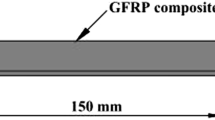Abstract
This paper presents the results of a current study on polypropylene matrix composites processed by injection, with two different glass fiber lengths and five different volume fractions. Physical and mechanical properties were obtained, namely flexural strength, stiffness modulus and fracture toughness. The mechanical properties of the composites increased significantly with the increase of the fibers volume fraction in agreement with the Counto model. The effect of water immersion time was also analysed. Immersion in water promotes a marked decrease in mechanical properties in the early seven-ten days, and afterwards tends to stabilize. Water causes a decrease of the relative strength which increases with fiber volume fraction and reaches about 29 % and 32 % for 20 % of 4.5 mm fiber length and for 25 % of 12 mm fiber length respectively, after 28 days immersion in water. Fracture toughness increases with fiber volume fraction and is always higher for 12 mm fiber length composites than for 4.5 mm fiber length composites.
Similar content being viewed by others
References
P. Wambua, J. Ivens, and I. Verpoest, Elsevier Science, Belgium, 2003.
S. Y. Fu, B. Lauke, E. Mader, C. Yue, and X. Hu, Compos. Part A-Appl. S, 31, 117 (2000).
J. L. Thomason, Compos. Part A-Appl. S, 33, 1641 (2002).
F. Ramsteiner and R. Theysohn, Composites, 10, 111 (1979).
J. L. Thomason, Compos. Part A-Appl. S., 38, 210 (2007).
S. C. Tjong and S. A. Xu, Compos. Sci. Technol., 62, 2017 (2002).
B. Mouhmid, A. Imad, N. Benseddiq, S. Benmedakhéne, and A. Maazouz, Polymer Testing, 25, 544 (2006).
N. Sato and T. Kurauchi, J. Mater. Sci., 19, 1145 (1984).
J. Karger-Kocsis and K. Friedrich, Compos. Sci. Technol., 32, 293 (1988).
S. Hashemi and J. G. William, Polym. Eng. Sci., 26, 760 (1986).
A. Espert, F. Vilaplana, and S. Karlson, Compos. Part AAppl. S, 35, 1267 (2004).
H. N. Dhakal, Z. Y. Zhang, and M. O. W. Richardson, Compos. Sci. Technol., 67, 1674 (2007).
A. Zafar, F. Bertocco, J. SchjØdt-Thomsen, and J. C. Rauhe, Compos. Sci. Technol., 72, 656 (2012).
J. L. Thomason, M. A. Wug, G. Schipper, and H. G. L. T. Krikor, Compos. Part A-Appl. S., 27A, 1075 (1996).
J. A. Ferreira, C. Capela, and J. D. Costa, Fiber. Polym., 11, 1181 (2010).
George Wypych, “Handbook of Fillers”, Toronto-New York, 1999.
S. Ahmed and F. R. Jones, J. Mater. Sci., 25, 4933 (1990).
Author information
Authors and Affiliations
Corresponding author
Rights and permissions
About this article
Cite this article
Ferreira, N., Capela, C., Ferreira, J.M. et al. Effect of water and fiber length on the mechanical properties of polypropylene matrix composites. Fibers Polym 15, 1017–1022 (2014). https://doi.org/10.1007/s12221-014-1017-y
Received:
Accepted:
Published:
Issue Date:
DOI: https://doi.org/10.1007/s12221-014-1017-y



